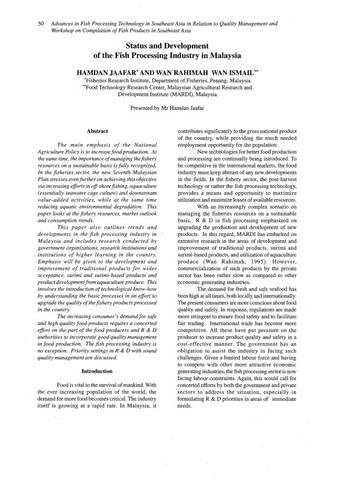Status and development of the fish processing industry in Malaysia
Share
Abstract
The main emphasis of the National Agriculture Policy is to increase food production. At the same time, the importance of managing the fishery resources on a sustainable basis is fully recognized. In the fisheries sector, the new Seventh Malaysian Plan stresses even further on achieving this objective via increasing efforts in off-shore fishing, aquaculture (essentially seawater cage culture) and downstream value-added activities, while at the same time reducing aquatic environmental degradation. This paper looks at the fishery resources, market outlook and consumption trends.This paper also outlines trends and developments in the fish processing industry in Malaysia and includes research conducted by government organizations, research institutions and institutions of higher learning in the country. Emphasis will be given to the development and improvement of traditional products for wider acceptance, surimi and surimi-based products and product development from aquaculture produce. This involves the introduction of technological know-how by understanding the basic processes in an effort to upgrade the quality of the fishery products processed in the country.The increasing consumer s demand for safe and high quality food products requires a concerted effort on the part of the food producers and R & D authorities to incorporate good quality management in food production. The fish processing industry is no exception. Priority settings in R & D with sound quality management are discussed.
Suggested Citation
Jaafar, H., & Ismail, W. R. W. (1997). Status and development of the fish processing industry in Malaysia. In K. K. Hooi, L. K. Low, & P. Y. Lim (Eds.), Proceedings of the seminar on the advances in fish processing technology in Southeast Asia in relation to quality management, Singapore, 29 October - 1 November 1996 (pp. 50-57). Singapore: Marine Fisheries Research Department, Southeast Asian Fisheries Development Center.

